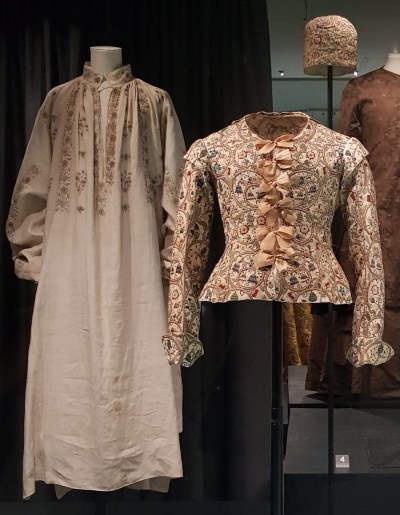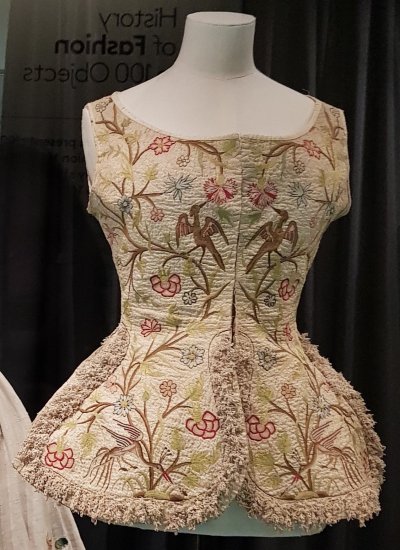I had the pleasure of visiting Bath Fashion Museum recently. In this post I’m going to share some of my photographs of the ‘treasures’ of the Fashion Museum.
You can read my earlier post on the special exhibition at the Fashion Museum, Royal Women: Public Life, Personal Style here.
Once again, a darkened exhibition with lighting reflecting off information boards on the opposite exhibition case caused me problems. Many of my pictures have been ‘ruined’ by the reflection marking a white rectangular box in the centre of an otherwise perfect shot. Mario Testino, I am not.
To enter the exhibition you head downstairs, I loved the glamour in the black and white framed pictures on the staircase.
The doeskin leather gauntlets (gloves of a triangular shape) are are believed to be King James I’s. However, they are unlikely to have been worn by King James when hunting, they are far too richly decorated and, according to the guide book, more likely to have been worn ceremonially.

Above left is a man’s embroidered shirt from the 1580s. It is one of the oldest pieces in the collection. Professional embroiderers, usually men in the sixteenth century, would have used a pattern from a contemporary pattern book. The embroidered jacket to the right is from the 1620s. The man’s nightcap, to the rear, is from the 1610s and would have been worn after a man had removed his wig. Following pattern books, nightcaps were embroidered by women in the home.

Above is an embroidered woman’s waistcoat from the 1700s. This would have been worn with a petticoat and open gown.
The open robe brocade-woven silk gown on the left is from the 1730s. It would have been worn with a petticoat. Large floral patterns were on trend. A decade later a closed robe was popular with Georgian women (centre). In the 1750s an open robe was again the popular choice worn with hooped petticoats beneath.
Top row pictures show a sack back dress from the 1770s. It is a brocade-woven silk gown, note the box pleats draping down the rear of the dress in the bottom picture. This would have been worn with side hoops.

Source:
Fashion Museum, Treasures, 2009
https://www.fashionmuseum.co.uk/events/history-fashion-100-objects












This was wonderfully. Waiting eagerly for part two.
LikeLiked by 1 person
Thanks 😁
LikeLiked by 1 person
So nifty! Love the photos and the fashions!
LikeLiked by 1 person
I have a lot of time on my hands whilst Dom is climbing Everest, so have added this to a list of places to visit. Thanks for enlightening me!
LikeLiked by 1 person
I forgot to put the price on the post. It was £9 but you can buy a saver ticket for 2 other attractions in Bath. I loved it!
LikeLiked by 1 person
Now there’s a thought, it’s high time I paid a return visit to Bath. I feel a visit to Sally Lunn’s coming on.
LikeLiked by 1 person
Thanks for this informative post!
LikeLiked by 1 person
Enjoyed reading this…..lovely pics!
LikeLiked by 1 person
Love the pieces here! Had no idea there was a fashion museum at Bath.
LikeLiked by 1 person